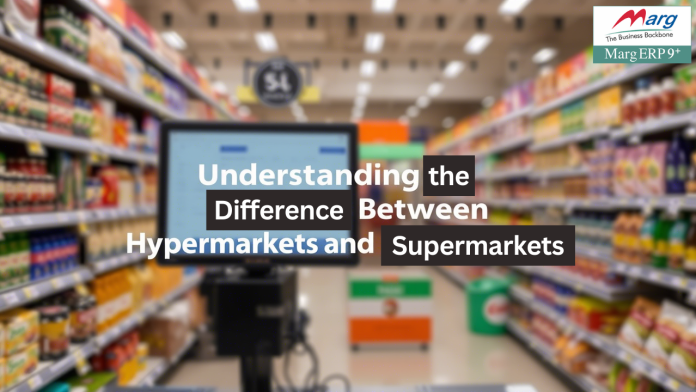In today’s fast-paced world, shopping for groceries, household essentials, and other daily necessities has become an integral part of our lives. With the rise of modern retail formats, consumers are often presented with a variety of options when it comes to choosing where to shop. Two popular retail formats that dominate the market are hypermarkets and supermarkets. While these terms are often used interchangeably, they represent distinct shopping experiences tailored to different consumer needs. In this blog, we will explore the hypermarket and supermarket difference, delve into what defines each format, and help you understand which one suits your lifestyle best.
What is a Supermarket?
- A supermarket is a self-service retail store that primarily focuses on selling groceries, fresh produce, dairy products, baked goods, and other essential household items.
- These stores are designed to cater to the everyday needs of consumers, offering a wide range of products under one roof.
- The layout of a supermarket is typically organized into aisles, making it easy for shoppers to navigate and find specific items quickly.
- Supermarkets are known for their convenience and accessibility. They are usually located in residential areas or community hubs, ensuring that customers can easily access them without traveling long distances.
- The size of a supermarket is relatively moderate compared to other retail formats, making it manageable for shoppers who want to complete their grocery shopping efficiently.
- One of the key characteristics of a supermarket is its focus on food and beverages. While some supermarkets may also stock non-food items like cleaning supplies, personal care products, and kitchenware, their primary emphasis remains on perishable and non-perishable food items.
- This makes supermarkets an ideal choice for individuals and families looking to stock up on weekly groceries or pick up last-minute essentials.
What is a Hypermarket?
- A hypermarket is a much larger retail format that combines the features of a supermarket and a department store.
- It offers an extensive range of products, including groceries, clothing, electronics, furniture, home appliances, and more.
- Hypermarkets are designed to provide a one-stop shopping experience, allowing customers to purchase everything they need in a single visit.
- The sheer size of a hypermarket sets it apart from a traditional supermarket. These establishments are often located on the outskirts of cities or in suburban areas, where there is ample space to accommodate their expansive layouts.
- Due to their large footprint, hypermarkets can house thousands of products across multiple categories, catering to a diverse audience with varying needs.
- Hypermarkets are particularly popular among shoppers who prefer bulk buying. They often offer discounts and promotions on bulk purchases, making them an attractive option for families or businesses looking to save money.
- Additionally, hypermarkets may include additional amenities such as food courts, entertainment zones, and even pharmacies, further enhancing the overall shopping experience.
Key Differences Between Supermarkets and Hypermarkets
To better understand the difference between supermarkets and hypermarkets, let’s break it down into key points:
Size and Layout
- Supermarket: Compact in size, designed for quick and efficient shopping. Organized into aisles with clearly marked sections for groceries, fresh produce, dairy, and other essentials.
- Hypermarket are Much larger, often sprawling across vast areas. Divided into multiple departments, each catering to specific product categories like groceries, electronics, clothing, and furniture. Requires more time to navigate due to its expansive layout.
Product Range
- Supermarket: Primarily focuses on food and beverages, including fresh produce, dairy, meat, and pantry staples. May stock limited non-food items like cleaning supplies and personal care products.
- Hypermarket Offers a broader range of products, including groceries, clothing, electronics, furniture, home decor, and even automotive accessories. Designed to fulfill all possible shopping needs in one place.
Target Audience
- Supermarket: Targets individuals and families seeking convenience and affordability. Ideal for urban dwellers who value proximity and ease of access.
- Hypermarket appeal to shoppers who prioritize variety and value for money. Families benefit from bulk purchasing options, while bargain hunters enjoy discounts on specialized products.
Pricing and Promotions
- Supermarket: Competitive pricing but may not always match the deep discounts offered by hypermarkets. Provides loyalty programs and personalized shopping experiences.
- Hypermarket: Offers lower prices due to bulk purchasing power. Frequently runs promotional campaigns, offering discounts on selected items or bundling products together.
Shopping Experience
- Supermarket: Streamlined and time-efficient. Customers can enter, pick up essentials, and check out within a short period.
- Hypermarket Requires more time and effort to navigate. Shoppers may spend hours exploring various departments, discovering new products, and enjoying additional amenities like food courts and entertainment zones.
Location and Accessibility
- Supermarket: Strategically located in residential areas, ensuring easy access for local communities. Parking facilities are modest, reflecting shorter visit durations.
- Hypermarket Often situated on the outskirts of cities or in suburban regions where land is affordable and spacious. Provides ample parking space to accommodate higher visitor volumes.
Which One Should You Choose?
Deciding whether to shop at a supermarket or a hypermarket ultimately depends on your individual needs and preferences. Here’s how to decide:
- If you value convenience, proximity, and a quick shopping experience, a supermarket is likely the better option for you. It’s perfect for picking up groceries, preparing meals for the week, or grabbing last-minute essentials.
- On the other hand, if you enjoy browsing through a wide variety of products, appreciate bulk-buying discounts, or are planning a major shopping trip, a hypermarket is the way to go. It offers the advantage of fulfilling multiple shopping needs in one outing, saving you time and potentially reducing costs.
Conclusion
Both supermarkets and hypermarkets play crucial roles in the retail landscape, each catering to different segments of consumers. Supermarkets excel in providing convenience and efficiency, making them indispensable for everyday grocery shopping. Hypermarkets, with their vast product ranges and value-for-money offerings, serve as destinations for comprehensive shopping experiences.
By understanding the hypermarket and supermarket difference, you can make smarter choices about where to shop based on your priorities. Whether you opt for the simplicity of a supermarket or the versatility of a hypermarket, both options ensure that your shopping needs are met effectively. So the next time you step out to shop, consider what you’re looking for—convenience or variety—and choose accordingly!
Read More:
- Simplifying GST Billing: A Comprehensive Guide to Invoice & Bill Formats
- Understanding the Difference Between Hypermarkets and Supermarkets
- What is GST Software for CA and How Does It Simplify Tax Management?
- The Ultimate Guide to Free Inventory and Billing Software
- Understanding Trade Expenses in Final Accounts











